| Columns Retired Columns & Blogs |
Simaudio Moon i3.3 integrated amplifier Measurements
Sidebar 3: Measurements
To perform the measurements on the Simaudio Moon i3.3, I mostly used Stereophile's loan sample of the top-of-the-line Audio Precision SYS2722 system (see the January 2008 "As We See It" and www.ap.com); for some tests, I also used my vintage Audio Precision System One Dual Domain and the Miller Audio Research Jitter Analyzer.
Before I did any testing of the Moon i3.3, I ran it at 33Wpc into 8 ohms for an hour. This power level (one-third the maximum of which the amp is capable) imposes the maximum heat stress on an amplifier with a class-AB output stage, and at the end of the hour, the Simaudio's heatsinks were way too hot to touch and its top plate was around 140°F (60°C). You should make sure that this amplifier is in a well-ventilated position. The THD+noise at this power level, with the amplifier stone cold, was 0.025%; after 60 minutes it had risen to 0.05%, but the amplifier seemed otherwise fine.
Although Erick Lichte didn't use it, the review sample of the i3.3 was fitted with the optional phono stage ($300), a small daughterboard at the right rear of the chassis. Internal jumpers allow this to be set to MM or MC modes, for the input impedance to be set to 100 or 47k ohms, and for the input capacitance to be switched between 0 and 100pF. The phono-stage gain, measured at the fixed line-level output, was approximately 5.5dB higher than the specified figures of 40 and 60dB (MM and MC, respectively), but this appeared to be due to the fact that the level from this output for line-level signals was 5.7dB higher than unity. Both MM and MC settings preserved absolute polarity (ie, were non-inverting), and the input impedances at 1kHz were close to specification, at 49k ohms (MM) and 101 ohms (MC). These impedances varied only slightly at different frequencies.
Fig.1 shows the departure of the RIAA equalization from true accuracy: The treble is shelved up by 0.4dB, and the right channel is 0.25dB higher in level than the left, but otherwise the channels match closely. The i3.3's phono board incorporates the IEC-recommended low-frequency rolloff, and the output rolls off sharply above 40kHz. The phono stage was pretty quiet for such an inexpensive option. The unweighted, wideband signal/noise ratio was excellent at 76.8dB (MM) and 62dB (MC), measured at the fixed outputs with the input shorted and referenced to 1kHz at 5mV and 500µV, respectively. A-weighting the measurements gave 88.5 and 65dB. The overload margins were also excellent, at 29dB at 20Hz and 26dB at 1kHz in both modes. The 20kHz margin was less good, however, at approximately 7dB. Stephen Mejias will be writing a "Follow-Up" review on this phono stage.
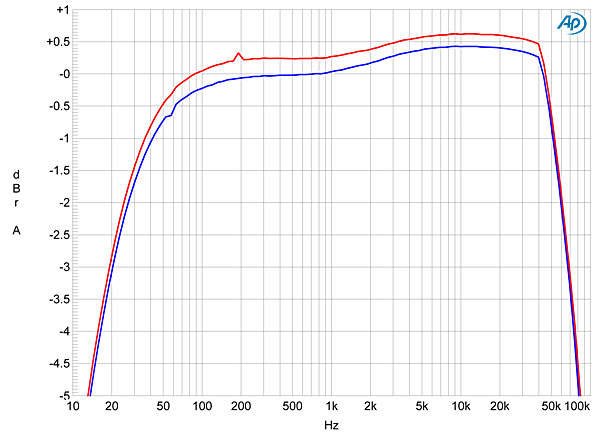
Fig.1 Simaudio Moon i3.3, phono input response with RIAA correction (left channel blue, right red). (0.5dB/vertical div.)
Moving on to the amplifier's performance from its line inputs, these also preserved absolute polarity, and offered an unbalanced input impedance of the specified 11k ohms at low and midrange frequencies, this dropping to 7k ohms at 20kHz. The balanced input impedance was twice these figures, as expected. The output impedance from the variable preamp jacks was a low 100 ohms. Measured at the speaker jacks, the i3.3 preserved absolute polarity and offered a sensible maximum gain of 35.3dB into 8 ohms for both the regular unbalanced inputs and the optional balanced outputs.
The output impedance was a very low 0.06 ohm over most of the audioband, rising to just 0.09 ohm at 20kHz. As a result, the variation in frequency response with our simulated loudspeaker (fig.2, gray trace) was minimal. This graph also shows that the i3.3 has an extended high-frequency response, the –3dB point lying at 90kHz. Commendably, this was not affected by the volume-control setting, and the 10kHz squarewave response featured very low risetimes (fig.3) and the 1kHz squarewave was beautifully square (fig.4).
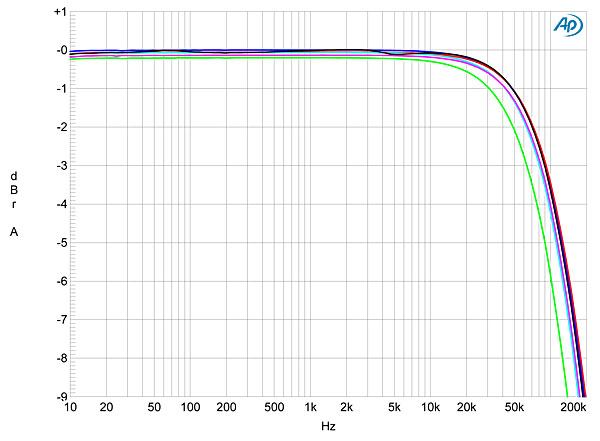
Fig.2 Simaudio Moon i3.3, frequency response at 2.83V into: simulated loudspeaker load (gray), 8 ohms (left channel blue, right red), 4 ohms (left cyan, right magenta), 2 ohms (green). (1dB/vertical div.)
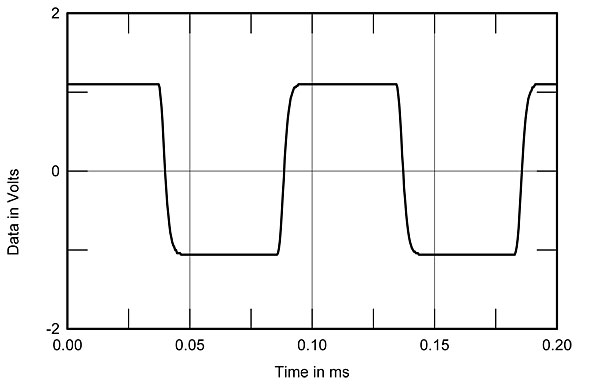
Fig.3 Simaudio Moon i3.3, small-signal 10kHz squarewave into 8 ohms.
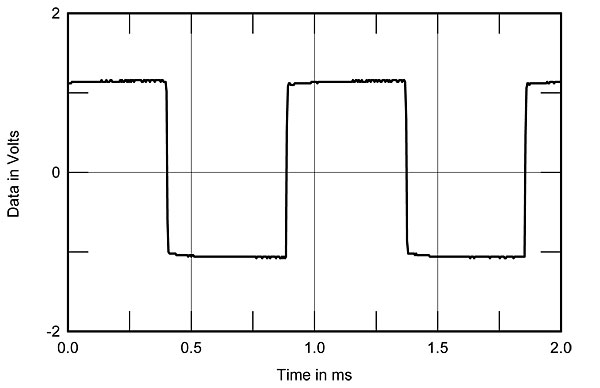
Fig.4 Simaudio Moon i3.3, small-signal 1kHz squarewave into 8 ohms.
Channel separation was good, at >80dB in both directions below 7kHz, and the wideband, unweighted S/N ratio (with the line input shorted but the volume control at its maximum) was a good 71dB ref. 1W into 8 ohms, improving to 75dB when A-weighted.
The background noise limited the THD+N measurement at low power levels, but the true distortion began to emerge from the noise floor at around 10W into 8 ohms and 30W into 4 ohms (fig.5). This graph also shows that, even with both channels driven, the Simaudio comfortably exceeds its specified maximum power, the 1% THD+N limit being reached at 130Wpc into 8 ohms (21.1dBW) and 210Wpc into 4 ohms (20.2dBW). I plotted the THD+N percentage against frequency at 9V (equivalent to 10W into 8 ohms), and you can see in fig.6 that while the distortion starts to rise in the top two octaves, particularly in the right channel, it remains low in absolute terms.
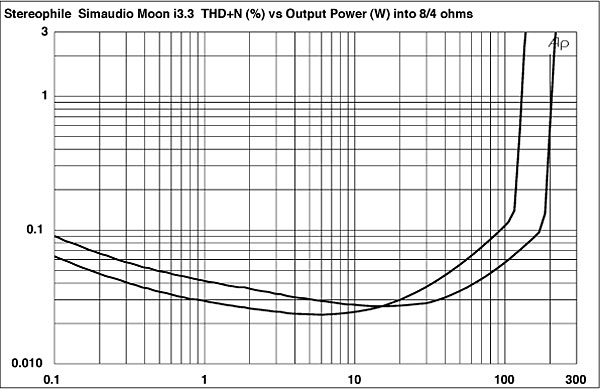
Fig.5 Simaudio Moon i3.3, distortion (%) vs 1kHz continuous output power into (from bottom to top at 1W): 8, 4 ohms.
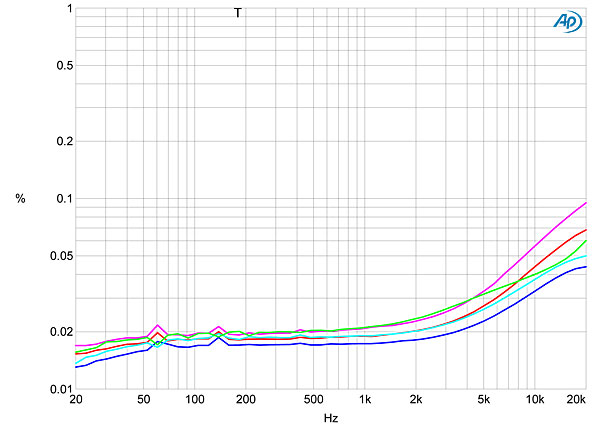
Fig.6 Simaudio Moon i3.3, THD+N (%) vs frequency at 9V into: 8 ohms (left channel blue, right red), 4 ohms (left cyan, right magenta), 2 ohms (green).
The distortion is strongly third-harmonic in nature (fig.7), which will be relatively benign in subjective terms. However, spectral analysis of the amplifier's output driving a high-power, low-frequency tone into 4 ohms (fig.8) reveals that, as well as some other low-order spuriae accompanying the third harmonic, spectral components are present at the odd harmonics of the 60Hz AC mains frequency. I experimented with the grounding between the amplifier and the Audio Precision test set but couldn't eliminate the spuriae. Though there is some 120Hz content present, which is the frequency of the raw full-wave-rectified supply, this is low in level, at –109dB and –104dB, left and right channels, respectively. The presence of odd-order harmonics of the 60Hz frequency suggests that these result from magnetic interference from the humongous toroidal transformer that occupies half the amplifier's internal real estate. So, even though the amplifier performs well on the high-frequency intermodulation test, with low levels of low-order intermodulation products (fig.9), the noise floor is marred by the 60Hz harmonics. It is fair to point out, however, that these drop to below –120dB above 2.5kHz, even in the noisier right channel.
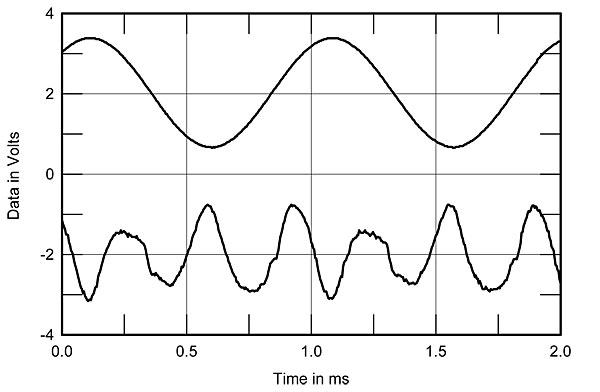
Fig.7 Simaudio Moon i3.3, 1kHz waveform at 10W into 4 ohms (top), 0.02% THD+N; distortion and noise waveform with fundamental notched out (bottom, not to scale).
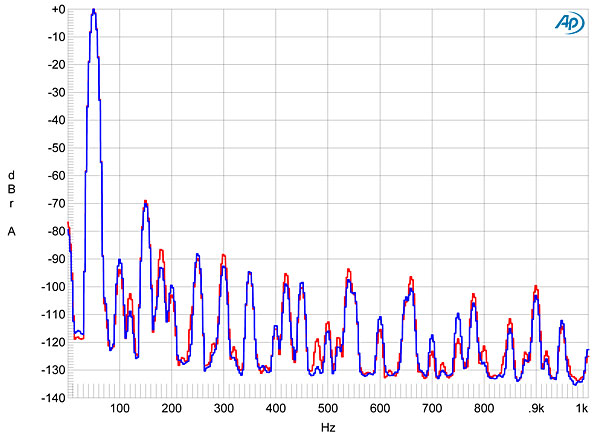
Fig.8 Simaudio Moon i3.3, spectrum of 50Hz sinewave, DC–10kHz, at 60W into 4 ohms (left channel blue, right red; linear frequency scale).
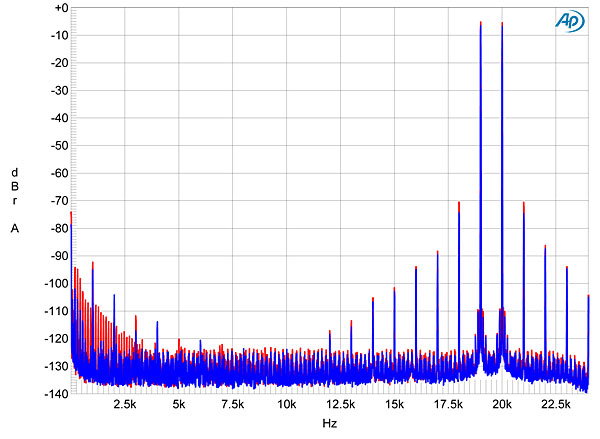
Fig.9 Simaudio Moon i3.3, HF intermodulation spectrum, DC–24kHz, 19+20kHz at 60W peak into 8 ohms (linear frequency scale).
Turning to the Moon i3.3's performance as a D/A converter, I measured its behavior at the fixed outputs with the volume control set to its minimum, to avoid stressing the power-amplifier section. The USB input uses the ubiquitous Burr-Brown PCM2705 receiver chip, which is limited to sample rates of 48kHz and below and to 16-bit data. The S/PDIF inputs successfully locked to data with sample rates ranging from 32 to 192kHz, though with the AP SYS2722's digital output, the i3.3's front-panel display stubbornly said "44.1kHz" regardless of the actual sample rate. It did display the correct sample rate with the digital output of the RME soundcard fitted to one of my lab PCs, however, and it appears that not all digital sources include the necessary metadata for the i3.3 to correctly display the sample rate. Simaudio will have a user-configurable firmware update for this by the time you read this review. In the meantime, it is important to note that the D/A board does correctly decode data regardless of the sample rate. This can be seen in fig.10, which shows the frequency response with data sampled at 44.1, 96, and 192kHz.
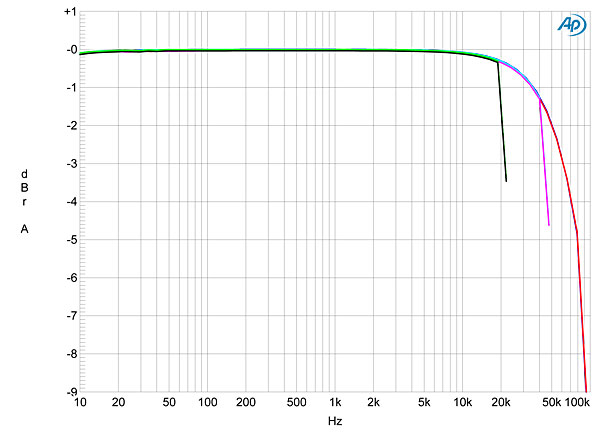
Fig.10 Simaudio Moon i3.3, frequency response at –12dBFS into 100k ohms with data sampled at: 44.1kHz (left channel green, right gray), 96kHz (left cyan, right magenta), 192kHz (left blue, right red). (1dB/vertical div.)
With my usual test for DAC resolution, in which I sweep a 1/3-octave bandpass filter from 20kHz to 20Hz while the device under test decodes dithered data representing a 1kHz tone at –90dBFS, increasing the word length from 16 to 24 bits drops the noise floor by around 10dB (fig.11). This suggest that the i3.3's digital board, which uses the 24-bit PCM1793 DAC chip from Burr-Brown, actually achieves closer to 18-bit performance. This is not quite good enough to resolve a tone at –120dBFS (fig.11, bottom pair of traces). The 60Hz-related spuriae can also be seen in this graph, as well as in FFT-derived spectra of the same –90dBFS data (fig.12).
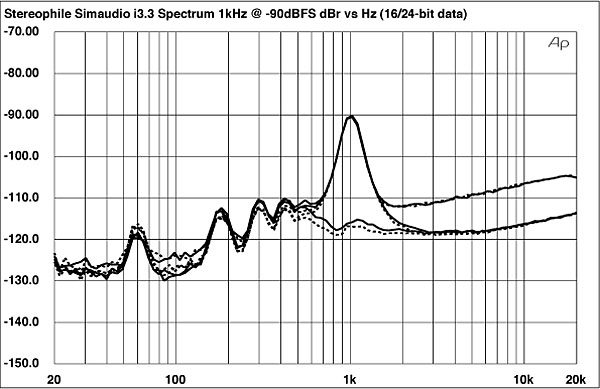
Fig.11 Simaudio Moon i3.3, 1/3-octave spectrum with noise and spuriae of dithered 1kHz tone at –90dBFS with 16-bit data (top) and 24-bit data (middle at 2kHz), and of dithered tone at –90dBFS with 24-bit data (bottom). (Right channel dashed.)
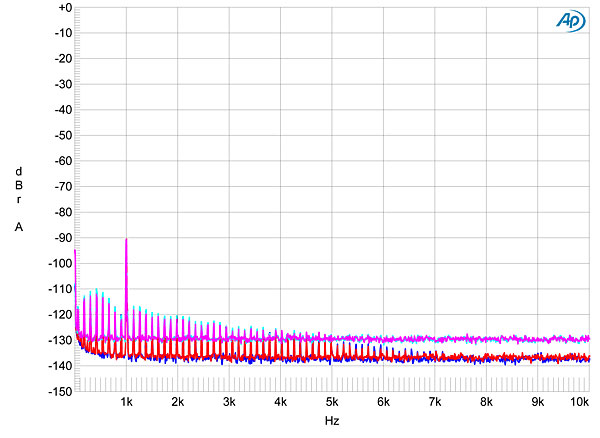
Fig.12 Simaudio Moon i3.3, FFT-derived spectrum with noise and spuriae of dithered 1kHz tone at –90dBFS with: 16-bit data (left channel cyan, right magenta), 24-bit data (left blue, right red).
The i3.3 made a fairly good attempt at correctly decoding undithered data representing a tone at exactly –90.31dBFS, which should consist of three DC voltage levels (fig.13). Increasing the bit depth gave a good, if rather noisy, representation of a sinewave (fig.14), and linearity error with 16-bit data was negligible down to below –105dBFS (fig.15). The Moon's D/A circuitry featured low distortion, the only harmonics accompanying a full-scale tone being the second and third, both at –100dBFS (0.001%, fig.16).

Fig.13 Simaudio Moon i3.3, waveform of undithered 1kHz sinewave at –90.31dBFS, 16-bit data (left channel blue, right red).
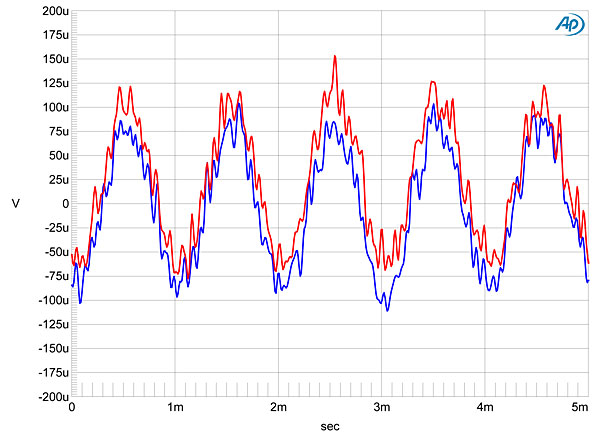
Fig.14 Simaudio Moon i3.3, waveform of undithered 1kHz sinewave at –90.31dBFS, 24-bit data (left channel blue, right red).
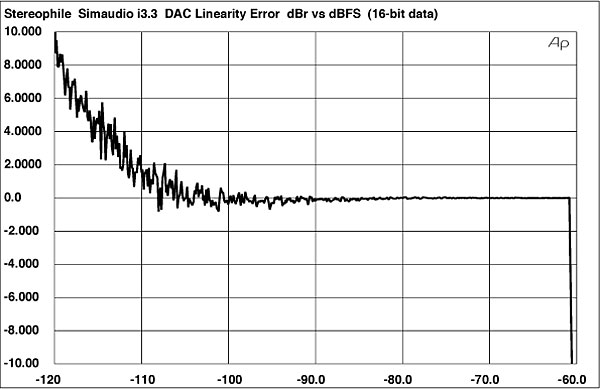
Fig.15 Simaudio Moon i3.3, left-channel linearity error, dBR vs dBFS, 16-bit data.

Fig.16 Simaudio Moon i3.3, spectrum of 1kHz sinewave at 0dBFS into 100k ohms (left channel blue, right red; linear frequency scale).
The i3.3's TosLink input showed fairly good rejection of interface jitter, with the Miller Analyzer measuring 575 picoseconds peak–peak. This primarily comprises data-related sidebands at ±229Hz (fig.17). Though the USB connection is not susceptible to interface jitter, performing a similar analysis with the same signal sourced from my MacBook revealed a rather messy-looking spectrum (fig.18), with sidebands present at 595ps p–p. The spectral peak representing the 11.025kHz tone is noticeably broadened at its base compared with fig.17, due to the presence of low-frequency random timing errors.
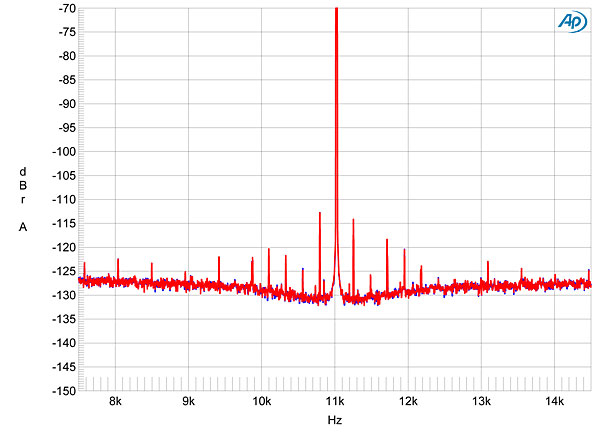
Fig.17 Simaudio Moon i3.3, high-resolution jitter spectrum of analog output signal, 11.025kHz at –6dBFS, sampled at 44.1kHz with LSB toggled at 229Hz, 16-bit data from PC via TosLink. Center frequency of trace, 11.025kHz; frequency range, ±3.5kHz (left channel blue, right red).
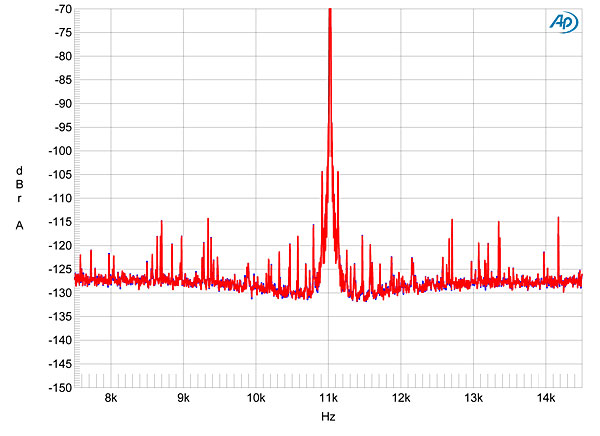
Fig.18 Simaudio Moon i3.3, high-resolution jitter spectrum of analog output signal, 11.025kHz at –6dBFS, sampled at 44.1kHz with LSB toggled at 229Hz, 16-bit data from MacBook via USB. Center frequency of trace, 11.025kHz; frequency range, ±3.5kHz (left channel blue, right red).
Simaudio's Moon i3.3 offers usefully high power in an attractively small package, though its use of a larger-than-normal AC transformer does somewhat pollute its noise floor. The optional phono stage measures well despite its low cost. The optional digital board offers good rather than great performance. I am not surprised that EL preferred the sound of the external CEntrance DACport, which is a bit of an overachiever for the same price as the Simaudio board.—John Atkinson
- Log in or register to post comments




































